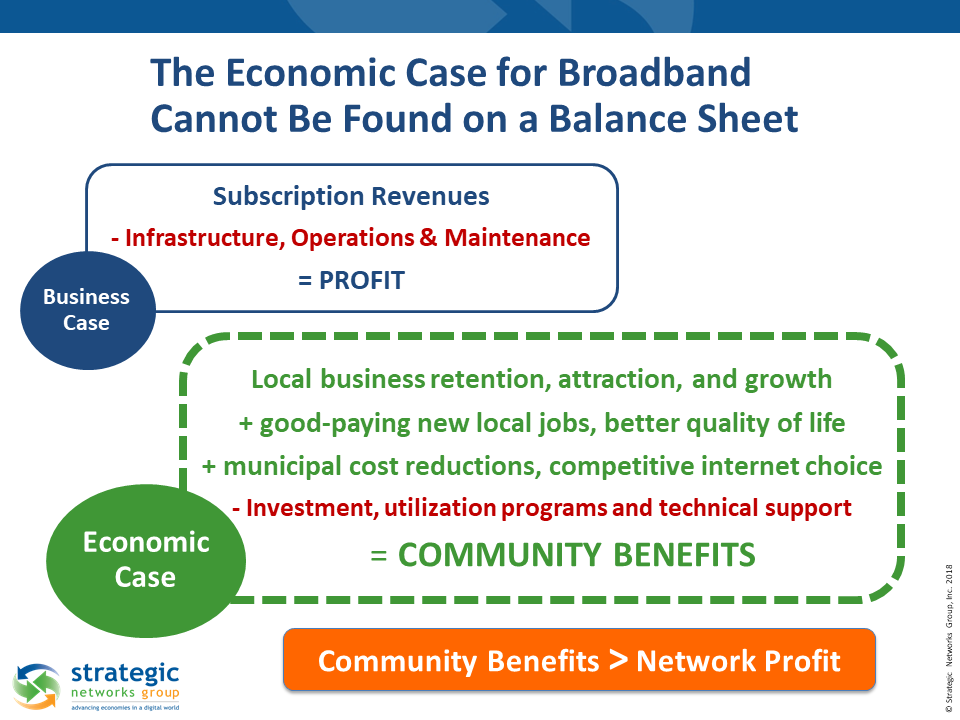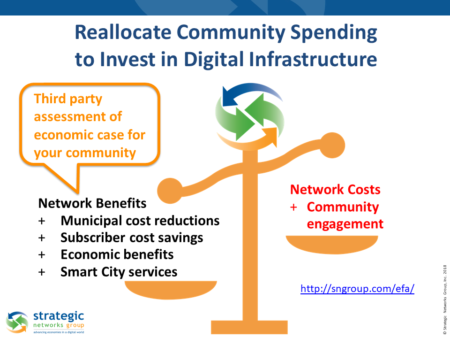Investing in Broadband as Infrastructure
We Don’t Have the Money – How Can We Afford Building-out Broadband?
Establishing a broadband network in unserved or underserved areas is a significant undertaking and in some cases prohibitively costly. When there is not enough of a private sector business case to invest in an area, a pivot is needed to look at broadband as an investment for the long term – as infrastructure. Localities need to focus on the question “Where do we want to be in 20 years, and how does broadband influence this strategy?” and then tactically thinking through actionable steps.
Getting broadband into unserved and underserved areas often face a number of unique challenges. Typical challenges for localities owning their own digital future include:
- Broadband not seen infrastructure, nor as an essential service for the community
- Lack of budget to fund new works, nor discretionary budget capacity
- Reluctance to fund broadband investment through local taxes
- Taxpayer resistance and political risk from citizen objections to municipal spending on broadband, or fear of raising taxes
- Negative perceptions of municipal or utility involvement in the free market
- Strong resistance by incumbent ISPs to losing their stated customer base

In an area where there is not enough of a business case for the private sector to invest in broadband, planning and community engagement are necessary to avoid pitfalls and address the challenges listed above.
Many network deployments have had challenges becoming sustainable because they have taken a build it and they will come approach. While people often initially focus on the network build, it is equally important to drive demand and build local capabilities to leverage technology.
An economic case for investing in broadband is possible when local residents and businesses are connecting to and fully leveraging broadband to achieve long-term community-based goals. For this, localities need to understand how to impact broadband demand at a micro-level by personalizing the value of online practices to individual businesses, organizations and households.
In addition to traditional sales and marketing efforts, increasing take rates and demand for higher value network services is needed to grow the business case for broadband investment. This requires community engagement, driving demand, and incentivizing implementation. At SNG we call this driving broadband utilization and community benefits. This is an essential element to building an economic case for investing in broadband.
Pivoting to an economic case for investing in broadband (or a community return on investment) requires understanding the market potential for broadband. To understand how a locality can grow from broadband is market research based on data collection, empirical evidence, and objective analysis to assess whether the benefits from an investment in digital infrastructure outweigh the costs. This is needed to assess the economic case for investing in broadband, as well for building buy-in around common goals and counter objections that may be based on unfounded claims.
A New Paradigm
A large part of overcoming the challenges requires a paradigm shift in how you think about broadband and digital infrastructure.
Broadband as infrastructure – First and foremost when considering broadband think of it as digital infrastructure that enables not only internet access, but also provides a platform for innovation and many other services. Rather than being a mechanism focused only on bringing better internet connectivity to the community, digital infrastructure opens up opportunities for many other new services that benefit the community.
Provide choice through open access – As a community, your goal is not to become an internet service provider. Your goal is to ensure that everyone in your community can get affordable, quality broadband if they want it. By ensuring that your broadband infrastructure is based on a wholesale model you can provide the needed bandwidth while lowering the cost of entry to even more retail internet providers. You not only avoid directly competing with incumbents, you actually encourage more healthy and competitive broadband marketplace.
Build based on committed demand – an economic case for digital infrastructure can be made by addressing the current and future needs of the locality itself, connecting municipal facilities as well as community organizations such as schools and libraries. This core network can then be extended more broadly to neighborhoods that demonstrate a committed demand to pay for that investment.
This last concept is a key paradigm shift that turns the traditional model on its head. You create a “win-win” by offering interested property owners the option to buy into the digital infrastructure from the outset on favorable financial terms. This new paradigm overcomes many of the challenges faced by traditional broadband network initiatives.
| The Challenges… | The Answers… |
|---|---|
Resistance by incumbent ISPs
| Build digital infrastructure
|
Lack of budget to fund new works
| Deploy based on committed demand
|
Taxpayer resistance – Political risk
| Do not implicate taxpayers
|
For an example of this paradigm at work please see how Ammon, Idaho, has implemented this approach.

